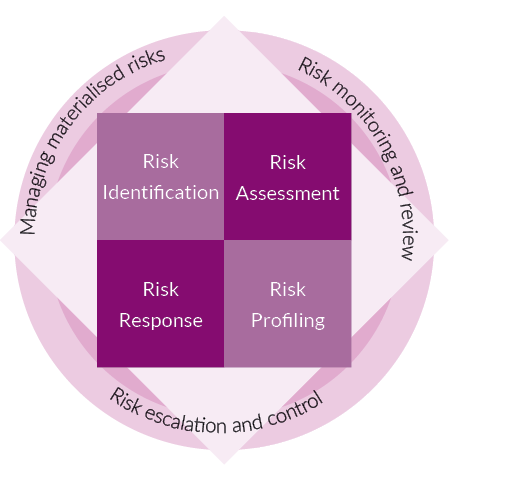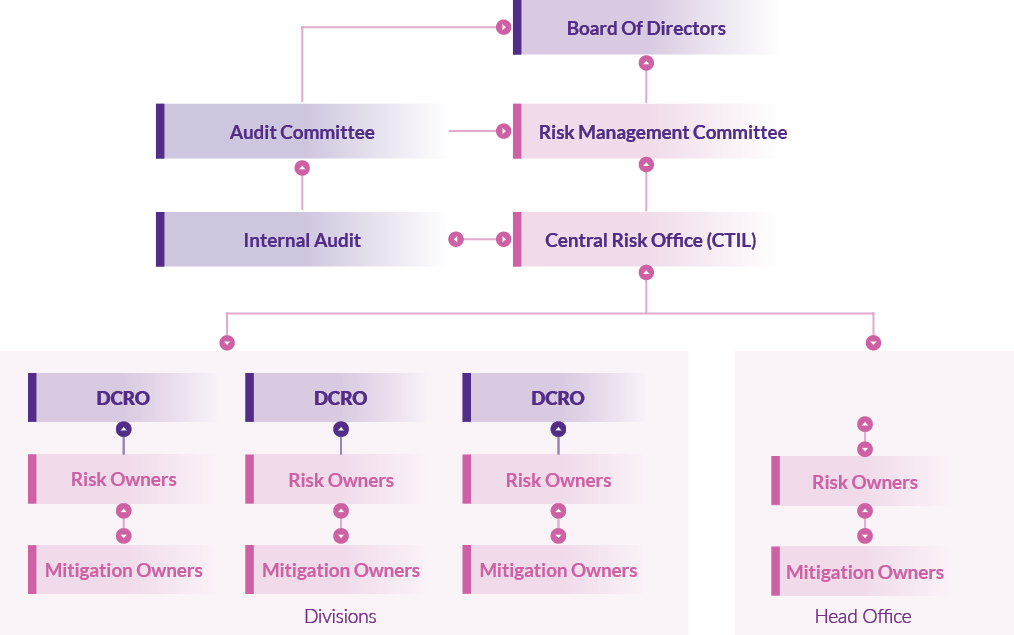Internal and External Environment


Risk Management
By implementing Enterprise Risk Management (ERM), we hope to improve and formalise risk management procedures at the corporate level, reduce risks in a planned and systematic way, and increase the trust of our wide range of stakeholders. The Risk Management Committee is the driving force behind the ERM framework and monitors its effectiveness. It keeps track of the enterprise risk management process' overall efficacy. By approving roles and duties for all stakeholders, the Board of Directors has established the expectations for ERM. Additionally, it keeps in close contact with the Central Risk Office for major adjustments and crucial business decisions. The Central Risk Office, which is now supervised by the CFO, is in charge of enabling the creation, implementation, and monitoring of risk management across the organisation. Each unit and business division are in charge of determining the likely hazards in its particular field of activity, which are subsequently escalated to management. Owners of risk and mitigation are in charge of overall ERM accountability.
Risk Governance Structure
The table presented below outlines the high-category risks (and one extreme category risk) identified at CTIL, along with their descriptions and the corresponding mitigation plans formulated by the Company to effectively manage these risks
CTIL

Cybersecurity
Cyber-attacks on the Company could result in possible losses for the Company through the use of out-of-date systems and new work-from-home / remote working environments
Short Term
Educating and Training people on vulnerability to cyber-attacks
Firewall installed
Operating system upgraded
Cyber insurance policy in place

Technology Risk
It is possible that the business continuity and disaster recovery plans won't work when needed
There is no Data Leakage Prevention (DLP) mechanism in place to track any organisational data leakage
Short Term
SAP drill conducted once every 6 months
BCP to be formalised
USB’s blocked across the organisation
MS Intune installed
Firewall for social media blocking
Risk
Description
Mitigation
Real Estate

Operational Risk
The completion of projects may be delayed by the need for approvals and procedural challenges brought on by excessive delays from government departments
Short Term
Pre-construction trackers in place
Review conducted every 15 days of local regulation
Best in class liason consultants
Risk
Description
Mitigation
Pulp and Paper

Technology Risk
Inability to meet the price/quality offered by competitors due to obsolete technology
Short Term
Technology upgradation and installation of new technology

Capacity
Inadequate capacity may lead to loss of opportunity
Short Term
Capacity expansion
Upgradation and expansion
Long Term
Continuously looking for opportunities

Raw Material Securitisation
Inadequacy or absence of raw material has the potential to impact operations
Short Term
Increasing green coverage and planting trees

Cost of Production
High cost of production can reduce profit margins
Short Term
Reduce cost of Chemicals and Packaging
Risk
Description
Mitigation
Textiles

Expansion Risk
Insufficient plant capacity and narrow product range concentration in home textile vertical leading to lower overall profitability of vertical
Short Term
Printed Products added
Outsourcing model
Risk
Description
Mitigation

Stakeholder Engagement
At CTIL, we see our stakeholders as allies in the process of generating long-term value. Therefore, achieving our strategic goals depends on effective and continuous stakeholder involvement. With an inclusive and integrated process, we aim to strike a balance between the needs, interests, and expectations of the business and those of our stakeholders.
In accordance with the board-endorsed strategy on stakeholder engagement, CTIL has developed an organised structure for drawing in with its stakeholders and cultivating relationship with each one of them. The Company’s approach is moored on the standards of materiality, fulfilment, and responsiveness. CTIL’s stakeholder identification and engagement strategy has evolved over the years, through continuous inputs from board members, employees, and other stakeholders. The stakeholder identification strategy that we followed is highlighted below:
Stakeholder identification strategy of CTIL

Identification and Prioritisation of key stakeholder groups

Identification of the mode of engagement with the key stakeholder groups

Collection of response from identified stakeholder, understanding their expectation, and developing action plans to address their concerns
Based on their importance, influence, and impact on our business verticals, we have identified our major stakeholders. This exercise was carried out in order to identify the gaps and create strategies to improve our relationships with the stakeholders. Our identified key stakeholders include the following:

Our Key Stakeholders

Investors and Shareholders

Regulatory Bodies/Government

Customers/Consumers

Supply Chain Partners

Community

Employees
Stakeholder Expectations and Value Creation
| Stakeholder Group | Significance of Relationship With CTIL | Key Expectations | Medium of Engagement | CTIL Approach to Stakeholder Satisfaction |
|---|---|---|---|---|

|
Employees are the backbone of our business. Their efforts are key in implementing our plans and sustaining corporate growth. |
|
|
|

|
Engagement with communities drives CTIL towards favourable working conditions that guarantee social acceptance and harmony, and positive impact in areas where we carry out operations, with respect to the economy, society, and the environment. |
|
|
|

|
Our supply chain partners give us operational sway to improve the value chain, be more affordable, sustainable, and customer-centric. |
|
|
|

|
Shareholders and Investors provide financial capital which is essential for the growth of the organisation. |
|
|
|

|
CTIL engages with regulatory bodies to properly understand compliance and takes measures to alter business practices as per regulatory changes. Moreover, governmental organisations provide CTIL with the required licences and authorisations to continue its business in a sustainable manner. |
|
|
|

|
Our customers give us the opportunity to establish long-lasting, mutually beneficial partnerships so that CTIL can achieve and maintain market leadership in specific sectors. Additionally, they enable business continuity and are actively involved in developing novel solutions to present-day problems. Moreover, our customers drive us to improve the quality and prices of our products. |
|
|
|





